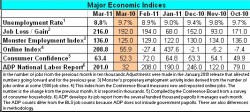![]() No April Fool’s joke here: The U.S. added 216,000 jobs in March as the unemployment rate crept down to 8.8 percent.
No April Fool’s joke here: The U.S. added 216,000 jobs in March as the unemployment rate crept down to 8.8 percent.
It is the second consecutive month of strong growth in private sector, non-farm jobs, providing additional evidence that the U.S. economy is gaining momentum. Today’s jobs report from the U.S. Bureau of Labor Statistics also offers support for the various surveys of the last few days predicting increased hiring.
Investors were obviously in the mood for a little good news. They sent the Dow up within minutes of the market’s opening. At 9:45 a.m. in New York, the Dow was up almost 43 points.
Economists had been expecting a much more modest jobs growth, with the consensus falling in the 190,000 area. They’d also anticipated that the unemployment rate would either remain flat at 8.9 percent or climb to 9.0 percent.
The other surprise in the BLS report were upward revisions to the job counts for January and February. Between the two months, 7,000 more jobs were added to the counts.
All the growth is coming from the private sector, which added a total of 230,000 jobs during March.
 Lead by the continuing growth in temp hiring — a leading indicator of an improving economy — the service sector overall added 199,000 jobs. Healthcare also was strong, adding 36.600 jobs with social services adding another 7,900 in the category. Restaurants and food service took a big jump, growing by 26,500 jobs.
Lead by the continuing growth in temp hiring — a leading indicator of an improving economy — the service sector overall added 199,000 jobs. Healthcare also was strong, adding 36.600 jobs with social services adding another 7,900 in the category. Restaurants and food service took a big jump, growing by 26,500 jobs.
Manufacturing, which added 17,000 jobs, and mining, in particular the oil and gas industry, added another 15,000 positions.
Tech was the only private sector to lose any significant number of jobs. Telecommunications was down 3,800, contributing the biggest part of the sector’s 4,000 job reduction.
Government, however, continued to be the largest loser. Local government cut 15,000 jobs, 9,200 of them in education. State governments were flat and only the federal government added positions.
Despite the job growth over the last several months, wages and hours are little changed. The BLS says average hourly earnings for all employees on private nonfarm payrolls was $22.87, up only 1.7 percent over the last 12 months. The average workweek was unchanged in March at 34.2 hours.
Meanwhile, there were 13.5 million officially unemployed workers in the country, of whom 6.1 million have been unemployed for at least 6 months. Another 2.4 million are out of work, but aren’t part of the official unemployed count because they didn’t look for work during the BLS survey period.
Add to the total 8.4 million more who are working at part-time jobs because they can’t find full time work.
As large as those numbers remain, the BLS report says there are 1.4 million fewer unemployed today than a year ago.
While the trend is positive, any number of international and domestic developments can slow or even derail the improvement. The turmoil in the Mideast has pushed up oil prices to their highest levels in a few years. As the price at the pumps increases, businesses may grow wary of pushing too fast. State governments, many of whom are now in the midst of developing budgets, are expected to continue to make cuts, some of them far deeper than in the past.
David Levy of the Jerome Levy Forecasting Center, told The New York Times, “The first half of this year will be the best job market that we’ll see in this whole expansion.”